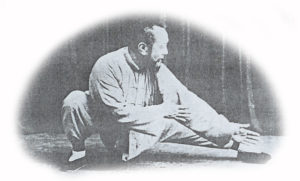When translated literally, Tai Chi Chuan (or Taiji quan in pinyin transcription) means something like “Great Universal Fist” or “Supreme Ultimate Boxing”. There are two parts to the name:
1. “Tai Chi”, which represents the ‘ultimate’, ‘supreme’ ascendant peak of Taoist philosophy and enlightenment, where ‘the one’ state of ultimate perfection and union is understood in it’s duality of Yin and Yang.
2. “Chuan”, which means ‘fist’, ‘boxing’ or ‘martial art’. Almost all Chinese martial arts are named as some kind of “Chuan”.
So, we have a Chinese martial art based around the Taoist co ncept of Yin and Yang, soft and hard, full and empty. This principle of duality is applied to the art of fighting – someone attacks you, which is an aggressive ‘Yang’ force, to which you respond with ‘Yin’ – getting out of the way, diverting the force with a minimum of effort, then following on with your ‘Yang’ (a strike) to your opponent’s ‘Yin’ (a weak point in the opponent’s defence or posture – perhaps the carotid artery or the groin).
ncept of Yin and Yang, soft and hard, full and empty. This principle of duality is applied to the art of fighting – someone attacks you, which is an aggressive ‘Yang’ force, to which you respond with ‘Yin’ – getting out of the way, diverting the force with a minimum of effort, then following on with your ‘Yang’ (a strike) to your opponent’s ‘Yin’ (a weak point in the opponent’s defence or posture – perhaps the carotid artery or the groin).
This Taoist approach to martial arts is the same as we see in Chinese Traditional Medicine and Health exercises – hence certain aspects of Tai Chi Chuan practice are medically beneficial. This health aspect of Tai Chi Chuan has become so popular that it has largely eclipsed any kind of martial arts training and practice. Most schools of Tai Chi Chuan simply practice the hand form and perhaps some Chi gung (Qigong) exercises. Almost none have any fighting or ‘martial arts’.
This is ironic, since Tai Chi Chuan became famous toward the end of 19th century precisely because of its’ efficacy as a martial art: a certain Yang Lu chan came to the Manchu court in Beijing, vanquished all challenges, and ended up teaching his art to the officers of the Imperial Guard. Before his time, the origins and development of the art are somewhat mysterious and controversial. Since that time, the art has propagated throughout China and then across the world.
Practical Tai Chi Chuan is the name adopted by Dan Docherty, for the style named by his master, Cheng Tin Hung, as “Wudang” Tai Chi Chuan. Cheng did not want his style to be associated with a particular family (standard Tai Chi school classification divides styles up into 5 families). Cheng had learnt from two sources. One, his uncle, was an inside-door student of Wu Jian Chuan (the founder of Southern Wu style) – to a great extent Wudang TCC is similar to Wu family style. The other teacher had learnt from two masters, neither of whom were in the Wu family lineage, but directly linked to Yang Lu chan and Chen village teaching.
We cannot say today that anyone really practices the “original” Tai Chi Chuan, whatever that may be. However, Wudang/Practical Tai Chi Chuan is arguably close to that apparent ideal.